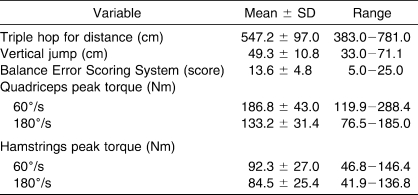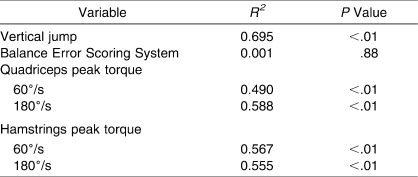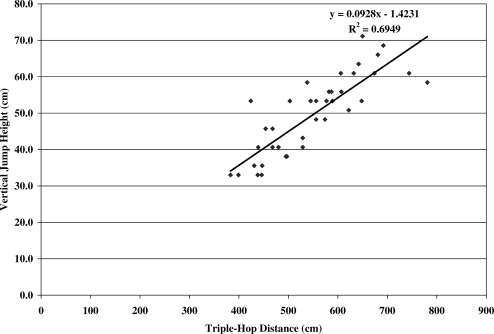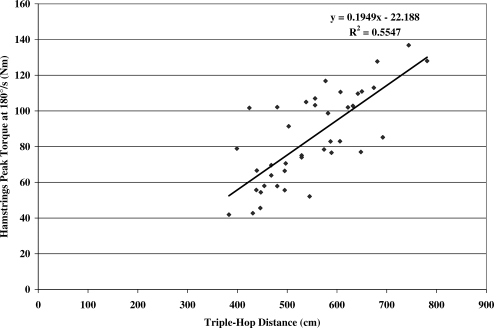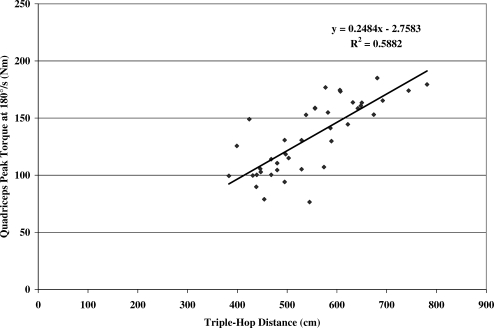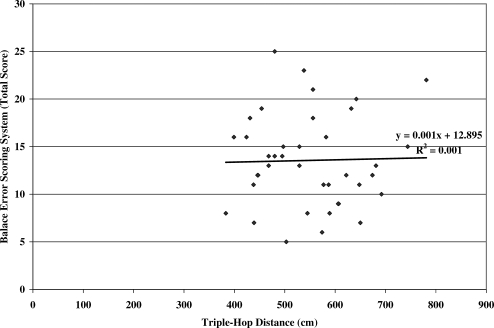Abstract
Context:
Hop tests are functional tests that reportedly require strength, power, and postural stability to perform. The extent to which a triple-hop distance (THD) test measures each of these characteristics is relatively unknown.
Objective:
To determine the extent to which the THD predicts performance on clinical measures of power, strength, and balance in athletic individuals.
Design:
Within-subjects correlational study.
Setting:
Station-based, preseason screening of athletes.
Patients or Other Participants:
Forty National Collegiate Athletic Association Division I-AA men's and women's soccer student-athletes (20 women, 20 men; age = 20.0 ± 1.4 years, height = 172.8 ± 9.2 cm, mass = 71.9 ± 8.9 kg).
Intervention(s):
As part of a comprehensive preseason screening of athletes, participants completed the Balance Error Scoring System (BESS) test, 3 trials each of the THD and vertical jump, and 5 repetitions each of concentric isokinetic quadriceps and hamstrings strength testing at 60°/s and 180°/s. Bivariate correlations and linear regression analyses determined the extent to which THD (cm) predicted each of the strength, power, and balance measures.
Main Outcome Measure(s):
Maximal vertical jump height (cm), total BESS error scores, and quadriceps (Quad60, Quad180) and hamstrings (Ham60, Ham180) isokinetic maximum peak torque (Nm) at 60°/s and 180°/s, respectively.
Results:
Triple-hop distance was a strong predictor of vertical jump height, explaining 69.5% of the variance (P < .01). THD also predicted 56.7% of the variance in Ham60 (P < .01), 55.5% of the variance in Ham180 (P < .01), 49.0% of the variance in Quad60 (P < .01), and 58.8% of the variance in Quad180 (P < .01). No relationships between THD and BESS scores were noted.
Conclusions:
Triple-hop distance is a useful clinical test to predict an athlete's lower extremity strength and power. Although THD was not a predictor of static balance, further research is needed to examine its relationship with more dynamic balance tests.
Keywords: functional performance tests, peak torque, balance, postural stability, open kinetic chain exercises
Key Points.
Triple-hop distance was a strong predictor of lower limb muscular strength and power in healthy collegiate soccer athletes, supporting the test's clinical use as a preseason screening test in this population.
Although triple-hop distance did not predict static balance as measured by the Balance Error Scoring System, more work is needed to determine the test's relationship with more dynamic balance tests.
Single-leg hop tests were designed to assess functional performance in an injured extremity.1–4 These functional hop tests are reported to require muscular strength, neuromuscular coordination, and joint stability in the lower limb1,3,4 and are considered useful in the clinical setting because they require minimal equipment and time and allow one to use the contralateral (eg, uninjured) limb as a reference for comparison.2,4,5 Designed to replicate the demands of sport and exercise, functional tests are used by clinicians to determine an individual's readiness to return to play after injury or illness. Researchers initially used hop tests in the evaluation of postsurgical knee patients, specifically those with anterior cruciate ligament reconstructions, and determined the hop test's validity as an objective clinical measure.1,2 In healthy populations, functional tests can be used to detect abnormal limb symmetry or weakness.6
Single-leg hop tests can be measured objectively and have been shown to be reliable,3–5,7 yet the clinical implications of performance deficits are not well understood. Noyes et al4 tested anterior cruciate ligament–deficient participants on 4 hop tests and found that 52% had abnormal limb symmetry during a single-leg hop test. However, they concluded that the tests were not able to detect the participant's specific functional limitations. That is, although limb asymmetries were noted, investigators were unable, from their study design, to determine the primary cause of abnormal function in injured participants (eg, strength or balance deficits).
Although hop tests are reported to test components of strength, power, and balance, the extent to which deficits on a single-leg hop test correlate with any of these factors has not been thoroughly investigated. Understanding these relationships would improve the clinical usefulness of the triple-hop distance (THD) in detecting imbalances and deficits in preseason screening and after injury. Therefore, our purpose was to determine the validity of THD by examining its ability to provide meaningful and accurate predictions of the participant's strength, power, and balance. Specifically, our intent was to examine whether THD was related to isokinetic quadriceps and hamstrings strength, vertical jump height, and static balance using the Balance Error Scoring System (BESS). Our expectation was that greater THD would predict greater leg strength and power and fewer postural balance errors.
Methods
Design
We used a within-subjects correlational design to determine if a participant's performance on the single-leg THD test predicted isokinetic quadriceps and hamstrings muscle strength, vertical jump (VJ) height, and scores on the BESS. After providing informed consent, the athletes participated in a multi-station, comprehensive preparticipation examination that included the following: a general medical screening, orthopaedic screening, general joint laxity and lower limb anatomic alignment measures, psychological survey, functional performance (eg, hop and jump tests) and agility testing, static balance tests, and kinematic analysis of landing. Athletes rotated through a total of 18 test stations, with the starting station randomly assigned after they completed the medical and orthopaedic screens. Approximately 5 weeks later, each subject reported to the athletic training room for isokinetic strength testing.
Participants
Forty National Collegiate Athletic Association (NCAA) Division I-AA men's and women's soccer student-athletes, ranging in age from 18 to 23 years, participated (20 women, 20 men; age = 20 ± 1.4 years, height = 172.8 ± 9.2 cm, mass = 71.9 ± 8.9 kg). Power calculations demonstrated that a sample of 40 participants was sufficient to detect an R2 value of .25, which represents a large effect. This criterion was considered acceptable because a large effect would be required to establish THD as a meaningful and accurate predictor of the dependent variables. Inclusion criteria were (1) active status on the men's or women's soccer roster, (2) completion of the preparticipation physical examination, (3) completion of all functional performance tests, and (4) clearance for participation. Exclusion criteria were (1) absence from any part of the preparticipation physical examination or (2) an inability to complete any of the 4 required tests. All volunteers gave informed consent to participate by signing a form approved by the university's institutional review board, which also approved the study.
Procedures
Isokinetic peak torques for knee extension (quadriceps strength) and knee flexion (hamstrings strength), VJ heights, BESS scores, and THD results were extracted for this study. The procedures for how each test was performed and how variables were defined are described below. We performed all tests on the participant's dominant limb, defined as the preferred stance leg used when the participant kicked a ball as far as possible. We identified the stance limb as the dominant limb, because we believed it would give the best estimation of the strength and power of the limb most often used by the participant to change the momentum of the body when in contact with the ground.
Triple-Hop Distance Test
We fixed a standard cloth tape measure to the ground, perpendicular to a starting line. Participants stood on the designated testing leg, with the great toe on the starting line. They performed 3 consecutive maximal hops forward on the same (dominant) limb. Arm swing was allowed. The investigator measured the distance hopped from the starting line to the point where the heel struck the ground upon completing the third hop.7 All participants were allowed 1 to 3 practice trials (self-selected) on each leg and then completed 3 test trials. Because participants already were warmed up sufficiently from performing the agility run tests (previous measurement station), the practice trials were provided to allow athletes to familiarize themselves with the test protocol. Practice trials were limited to 3 on each leg to avoid the effects of fatigue. A test trial was repeated if the participant was unable to complete a triple hop without losing balance and contacting the ground with the opposite leg. The maximum distance achieved during the 3 trials was recorded in centimeters and was used for analysis. Participants wore self-selected athletic footwear during the test. The test-retest reliability of this standardized protocol has been established for our laboratory (intraclass correlation coefficient [2,k] = .98, SEM = 16.1) and also demonstrated in previous research.7
Balance Error Scoring System
The BESS is a valid and reliable measure of postural stability and comprises 6 stance conditions: double-leg, single-leg, and tandem stances on both a firm surface and a foam surface.8 The foam surface consisted of a 6.35-cm (2.5-in)–thick, closed-cell Airex balance pad (Alcan Airex AG, Sins, Switzerland). Each of the 6 conditions was performed for 20 seconds, with eyes closed. Participants performed trials facing a wall to minimize distraction. A stopwatch was used for timing, and errors were observed visually and were recorded manually. Balance errors during each testing condition were determined as described by Riemann et al,8 with 1 error recorded for each of the following: (1) lifting hands off iliac crests; (2) opening eyes; (3) stepping, stumbling, or falling; (4) remaining out of the test position for more than 5 seconds; (5) moving the hip into more than 30° of flexion or abduction; or (6) lifting the forefoot or heel. We then summed the total errors across the 6 conditions and used the total score for analysis.
Vertical Jump
The VJ was performed using a countermovement jump that has been described previously in the literature9–11 and has been shown to be a reliable11 and valid9,10 measure of power output in athletes. Participants were tested wearing the same self-selected athletic footwear worn during the THD. Testing began by having the participants stand beneath the Jump It measurement standard (Excel Sports Products, Costa Mesa, CA), with the side of the preferred reach hand positioned closest to the standard and feet flat on the ground and shoulder width apart. The Jump It consists of an aluminum standard on a sand-filled base; spring pegs are placed at 2.54-cm (1-in) increments along the standard. First, stand-and-reach height was recorded by having the participant extend the preferred reach hand as high as possible with feet flat on the floor. Next, we instructed the participant to bend the hips and knees, and then, without pausing, jump as high as possible and contact the highest peg reachable on the Jump It measurement standard. Jump-and-reach height was then recorded, and VJ height was calculated by subtracting the stand-and-reach height from the jump-and-reach height. During the countermovement jump, arm swing was allowed, but an approach step was not permitted. The depth of the countermovement was not controlled, and participants were allowed to flex their hips and knees to a comfortable angle. Participants were permitted 1 to 3 practice jumps before completing 3 test trials. The maximal height reached during the 3 test trials was recorded in centimeters and was used for analysis.
Isokinetic Strength Testing
Isokinetic strength testing was assessed using a Biodex System 3 Pro Dynamometer (Biodex Medical Systems, Shirley, NY) at angular velocities of 60°/s and 180°/s with a university-specific protocol that had been developed and used in previous years by the clinical athletic training staff for baseline testing. All strength testing for this study was performed by the primary author (R.T.H.). Previous researchers have established the mechanical reliability of the Biodex12 and have shown that reciprocal, concentric peak torque measures obtained at 60° and 180° are very consistent from day to day when a standardized protocol is used.13,14
Participants were tested for concentric knee extension and flexion in a seated position, with hip and thigh stabilization straps applied. Seat angle was set at 85° and the knee angle at 90°. The knee axis of rotation was aligned with the dynamometer shaft, and the lower edge of the resistance pad was placed just superior to the medial malleolus and was secured with a stabilization strap. Range-of-motion stops were set at 90° of flexion and 20° of extension for a total range of motion of 70°, and gravity correction was performed. The rationale for using a 20° extension limit for this baseline testing protocol was for better comparisons with strength values after injury or surgery, when full extension may be voluntarily or involuntarily limited. Participants warmed up on a cycle ergometer for 5 to 10 minutes, followed by self-directed quadriceps and hamstrings stretching. Following set-up on the dynamometer, the nondominant limb was always tested first. Although a separate reliability study was not performed for this limited-range protocol, researchers15 have shown that reducing the range of motion does not compromise reproducibility of peak torque values.
Before testing, all participants completed a standardized familiarization protocol that consisted of 4 consecutive increasing efforts. Participants were instructed to perform the first repetition at 25% of maximal effort, the second repetition at 50% of maximal effort, the third repetition at 75% of maximal effort, and the fourth repetition at maximal effort. Once the participant completed this familiarization protocol, he or she performed 5 reciprocal concentric test repetitions at 60°/s. During the test repetitions, we gave verbal encouragement to apply force “as hard and as fast as possible” for both knee extension and flexion, on every repetition. The participant then was given a 10-second recovery, after which he or she performed familiarization and testing repetitions at 180°/s. We then tested the dominant limb using the same procedures. After testing was completed, participants cooled down on the cycle ergometer.
Isokinetic quadriceps (Quad60, Quad180) and hamstrings (Ham60, Ham180) peak torques at each angular velocity (60°/s and 180°/s) were recorded via the Biodex software (version 2.15 beta; Biodex Medical Systems). The test repetitions with the highest peak torque (Nm) for each measure were recorded and were used for analyses.
Statistical Analyses
We recorded descriptive data (means, SDs, and range values) for each variable. Because this was a within-subjects correlational design, data were not normalized by height or weight. Bivariate correlations and simple linear regression analyses determined the extent to which THD predicted each of the dependent variables: VJ, BESS, Quad60, Quad180, Ham60, and Ham180. Alpha level was set for all analyses at .05.
Results
Table 1 provides the descriptive statistics for THD, VJ, BESS, Quad60, Quad180, Ham60, and Ham180. Table 2 lists the bivariate Pearson correlations comparing each of the strength, power, and balance measures with THD. Table 3 presents the linear regression summary results when predicting each of the dependent variables from the participant's performance on the THD test.
Table 1.
Triple-Hop Distance, Vertical Jump, and Balance Error Scoring System Results and Quadriceps and Hamstrings Peak Torque at 60°/s and 180°/s
Table 2.
Bivariate Pearson Correlations for Triple-Hop Distance, Vertical Jump, Balance Error Scoring System, and Quadriceps and Hamstrings Peak Torque
Table 3.
Linear Regression Results for Triple-Hop Distance Predicting Vertical Jump (VJ), Balance Error Scoring System, and Quadriceps and Hamstrings Peak Torques
The THD result was correlated significantly with VJ height, Quad60, Quad180, Ham60, and Ham180 but not BESS scores. The THD was a strong predictor of VJ height (Figure 1), explaining 69.5% of the variance (Table 3) and yielding a prediction equation of YVJ = −1.42 + 0.093XTHD, with greater THD predicting greater VJ height. The THD was also a strong predictor of quadriceps and hamstrings strength at both 60°/s and 180°/s, predicting 49.0% and 58.8% of the variance, respectively, in these values (Table 3). The respective prediction equations for these relationships follow:
Figure 1. Triple-hop distance predicting vertical jump height.
Figure 3. Triple-hop distance predicting hamstring muscle strength measured at an angular velocity of 180°/s.
Figure 2. Triple-hop distance predicting quadriceps muscle strength measured at an angular velocity of 180°/s.
The THD was not a significant predictor of performance on the BESS (Table 3, Figure 4).
Figure 4. Triple-hop distance predicting Balance Error Scoring System error scores.
Discussion
The primary finding of this study was that THD was a strong positive predictor of performance on clinical power and strength tests. This result suggests that THD is a valid test of lower limb power and strength in National Collegiate Athletic Association Division I soccer players. However, we found no relationship between THD and balance as measured by the BESS. The following discussion addresses the relationships noted between THD and each of the dependent measures.
Power
Single-leg hop-for-distance tests and VJ tests are both considered functional tests and are reported in the literature to be useful as part of a battery of tests to determine readiness to participate in activity.16 However, to our knowledge, no previous authors have examined the validity of the THD test as an accurate predictor of leg power in a healthy population as measured by the countermovement VJ, which represents the field test most commonly used in the literature to predict power output.9,10 The VJ requires lower limb power in order to achieve maximal height, and significant improvements have been noted in countermovement jumps after training with rapid, stretch-shortening knee extension contractions.17 Just as VJ height depends upon power applied vertically, the THD test requires the generation of leg power to maximize horizontal distance. Despite the difference in body positioning between THD and VJ, one may infer that similar muscle activity occurs to produce extension at the hip, knee, and ankle joints. This concept is supported by Gustavsson et al,16 who determined that a single-leg VJ test and single-leg hop-for-distance test were highly correlated (rs = .70 to .94, P = .01). Given the close relationship between a single-hop test and THD,6 it is not surprising that THD predicts VJ performance. Hence, these data suggest that THD also may be used as a valid predictor of lower limb power that can provide similar results to the VJ in determining functional performance deficits.18 The advantage of the THD (and other single-leg hop and jump tests) over the standard, double-leg VJ is that each leg can be evaluated independently, so that asymmetries may be identified. Further, no equipment other than a cloth tape measure is required for the THD, which may be particularly advantageous for high schools, sports clubs, and other clinical settings with severely limited finances.
Strength
Previous authors3,4,19 have examined the relationship between performance on a single-leg hop test and lower limb strength tests. However, we found only 1 group6 that investigated the validity of THD in accurately predicting lower limb strength in a healthy population, and this was limited to knee extensor strength. In the current study, THD was an equally strong predictor of quadriceps and hamstrings strength as measured at 60°/s and 180°/s. Further, the variance explained was relatively consistent at both angular velocities for the hamstrings, but THD explained approximately 10% more of the variance in the quadriceps at 180°/s compared with 60°/s. Our findings relative to quadriceps strength are consistent with those of Ostenberg et al,6 who reported similar but slightly lower relationships between THD and quadriceps strength at 60°/s (R2 = .43) and 180°/s (R2 = .52), with the prediction model being 9% stronger at the higher velocity. It may be that the higher-velocity quadriceps strength assessment is more in line with the functional demands for rapid strength development of the quadriceps during the THD and, therefore, yielded a slightly better prediction model.
Soccer is a sport that clearly involves both open kinetic chain and closed kinetic chain strength to perform various multidirectional movements as well as kicking a ball. The strong relationship between isokinetic testing and THD in our study supports a relationship between open kinetic chain and closed kinetic chain muscle performance. However, comparisons with studies previously cited in the literature are somewhat difficult due to differences in protocols, investigators, and angular velocities tested. Although previous authors3,4,19 demonstrated a relationship between isokinetic quadriceps strength at numerous angular velocities and single-leg hop tests, only 1 other group6 specifically examined the ability of THD to predict thigh strength, and this was limited to quadriceps strength in female soccer players. These limited results show promise as to how this simple, functional performance field test may be used by clinicians and strength and conditioning specialists as a gross predictor of thigh strength at low to moderate angular velocities. Whether these relationships hold at higher angular velocities and for other sport populations is unknown and merits further study.
Balance
Our hypothesis that greater BESS error scores (ie, decreased postural control) would predict decreased performance on the THD was not supported. In fact, the correlation matrix indicates that performance on the BESS was not significantly related to any of the tests performed. Although the BESS has been found to be a valid20 and reliable8 clinical measure of postural stability and has been demonstrated to be sensitive in detecting functional balance deficits due to functional ankle instability,21 we are the first to our knowledge to examine the relationship between a static balance test and performance on the THD test or any other functional hop test in healthy participants.
Balance is defined as the process of maintaining center of gravity over the base of support. Balance depends upon interaction among the visual, vestibular, and somatosensory systems.22,23 This collective sensorimotor system is the primary source of proprioceptive information among healthy adults24 and is organized to provide feedback to the central nervous system, where effector muscles coordinate activity to generate supportive reactions for balance.22 Hence, it would seem reasonable that during the THD test, sufficient postural balance would be required to ensure that the body remained optimally positioned over the base of support during each single-leg landing phase, so that maximal muscular efficiency propels the body in a vertical and forward direction to achieve maximal distance. Given the lack of relationship between BESS error scores and THD in our study sample, we considered possible explanations for these findings.
A number of differences in how the BESS and THD were performed in the current study may have confounded potential findings. Participants wore shoes for the THD but not for the BESS. Further, a foam surface was used specifically to provide conflict to the somatosensory system during the BESS, and the participant's eyes remained closed during all balance tests.8,22,24 Therefore, both visual and somatosensory integration were confounded during all (visual) or some (somatosensory) conditions of the BESS, whereas no systems were confounded during the THD test protocol. Given these potential confounds and the fact that the BESS is performed during static stance, it is possible that THD may better predict results on a more functionally relevant, dynamic balance test such as the Star Excursion Balance Test.25,26 The Star Excursion Balance Test is a 1-leg reach test designed to challenge the individual's limits of stability and is reported to require adequate range of motion and strength of ankle dorsiflexion, knee flexion, and hip flexion, as well as adequate proprioception and neuromuscular control to perform these reaching tasks.27 Further research is needed to determine the extent to which THD may be related to this and other similar dynamic postural tests.
In addition, it should be noted that our participants were not required to maintain their balance during the final landing of the THD test. The extent to which this may have affected the challenge to the postural control system is unclear. However, recent researchers examined time to stabilization after a single-leg jump landing as a measure of dynamic postural stability28,29 and found it to be more sensitive in detecting postural deficits than a static balance test. Hence, future studies that require the participant to hold and stabilize the body during the final landing of the THD test may further challenge the sensorimotor system, potentially increasing the clinical usefulness of this functional performance test in predicting postural control deficits.
Clinical Relevance
Triple-hop distance was designed originally as a test for those recovering from injury or surgery to gauge readiness for activity1 and frequently has been reported to require a combination of muscular strength, power, and balance.1,3,4 However, the extent to which THD accurately relates to or measures deficits in any of these components has not been quantified previously. Examining these relationships may prove useful in maximizing the validity and efficiency of this and other functional performance tests as preseason screening and postinjury evaluations. Our findings demonstrate that THD is a strong predictor of lower limb muscular strength and power in a healthy soccer population and support its clinical usefulness as a preseason screening test in a coeducational NCAA Division I soccer population.
Based on these findings, the perceived advantages of the THD test are that it requires minimal space, time, and equipment and may be especially helpful at youth or high school levels, where resources are limited and sophisticated testing equipment is not available. With this goal in mind, future authors should examine the ability of THD to predict muscular strength and power in individuals across various sports, at different ages, and during the rehabilitation progression after injury. Because our study was not powered to examine these relationships separately by sex, future investigators should examine whether these predictions hold equally well for men and women. Given the slightly higher relationships between quadriceps strength and THD at 180°/s compared with 60°/s, the relationship between THD and isokinetic strength tests at higher angular velocities, as well as lower limb eccentric strength, should be explored also. Although THD was not found to predict static balance as measured by the BESS, further work is needed to determine its clinical usefulness as a predictor of dynamic postural control relative to measures of limits of stability and time to stabilization.
Limitations
We acknowledge some limitations with this study. Because we collected data as part of a large preseason screening of athletes, we used multiple testers to obtain the measures and could not strictly control test order. However, the same tester took all measurements on a single variable, except for the BESS, which required 2 examiners. Further, the more complex and time-intensive nature of isokinetic testing made it impractical for us to test the strength of the participants at the same time as our other preseason screening measures and therefore required us to measure quadriceps and hamstrings strength at an alternate time. This was because the strength-testing protocol took close to 20 minutes per participant to complete, and all other stations required only 2 to 5 minutes. Unfortunately, due to other schedule constraints at the start of the season, approximately 5 weeks elapsed between the time of the preseason screen and completion of strength testing by the investigator. During this time interval, the participants took part in soccer practices and games and strength training for 1 to 3 weeks before the second testing session. Therefore, it is possible that strength gains may have occurred during this interval. Collectively, these limitations may have resulted in increased measurement variability, which may have reduced to some extent the relationships noted. Another perceived limitation may be the limited 70° arc of motion and relatively short rest interval that were used in our standardized isokinetic test protocol. Although these factors may have affected peak torque measures to some extent, they were standardized across all participants, and thus, any systematic changes in peak torque values would have had no effect on the prediction models. Further, the short rest interval likely had little effect on our strength measures in these well-trained Division I student-athletes.
Footnotes
R. Tyler Hamilton, MS, ATC, and Sandra J. Shultz, PhD, ATC, CSCS, contributed to conception and design; acquisition and analysis and interpretation of the data; and drafting, critical revision, and final approval of the article. Randy J. Schmitz, PhD, ATC, contributed to conception and design; acquisition and analysis and interpretation of the data; and critical revision and final approval of the article. David H. Perrin, PhD, ATC, FACSM, contributed to conception and design, analysis and interpretation of the data, and critical revision and final approval of the article.
References
- 1.Daniel D.M, Malcolm L, Stone M.L, Perth H, Morgan J, Riehl B. Quantification of knee stability and function. Contemp Orthop. 1982;5(1):83–91. [Google Scholar]
- 2.Daniel D.M, Stone M.L, Riehl B, Moore M.R. A measurement of lower limb function: the one-leg hop for distance. Am J Knee Surg. 1988;1(4):212–214. [Google Scholar]
- 3.Barber S.D, Noyes F.R, Mangine R.E, McCloskey J.W, Hartman W. Quantitative assessment of functional limitations in normal and anterior cruciate ligament-deficient knees. Clin Orthop Relat Res. 1990:255:204–214. [PubMed] [Google Scholar]
- 4.Noyes F.R, Barber S.D, Mangine R.E. Abnormal lower limb symmetry determined by function hop tests after anterior cruciate ligament rupture. Am J Sports Med. 1991;19(5):513–518. doi: 10.1177/036354659101900518. [DOI] [PubMed] [Google Scholar]
- 5.Ross M.D, Langford B, Whelan P.J. Test-retest reliability of 4 single-leg horizontal hop tests. J Strength Cond Res. 2002;16(4):617–622. [PubMed] [Google Scholar]
- 6.Ostenberg A, Roos E, Ekdahl C, Roos H. Isokinetic knee extensor strength and functional performance in healthy female soccer players. Scand J Med Sci Sports. 1998;8(5, pt 1):257–264. doi: 10.1111/j.1600-0838.1998.tb00480.x. [DOI] [PubMed] [Google Scholar]
- 7.Bolgla L.A, Keskula D.R. Reliability of lower extremity functional performance tests. J Orthop Sports Phys Ther. 1997;26(3):138–142. doi: 10.2519/jospt.1997.26.3.138. [DOI] [PubMed] [Google Scholar]
- 8.Riemann B.L, Guskiewicz K.M, Shields E.W. Relationship between clinical and forceplate measures of postural stability. J Sport Rehabil. 1999;8(2):71–82. [Google Scholar]
- 9.Johnson D.L, Bahamonde R. Power output estimate in university athletes. J Strength Cond Res. 1996;10(3):161–166. [Google Scholar]
- 10.Sayers S.P, Harckiewicz D.V, Harman E.A, Frykman P.N, Rosenstein M.T. Cross-validation of three jump power equations. Med Sci Sports Exerc. 1999;31(4):572–577. doi: 10.1097/00005768-199904000-00013. [DOI] [PubMed] [Google Scholar]
- 11.Stockbrugger B.A, Haennel R.G. Validity and reliability of a medicine ball explosive power test. J Strength Cond Res. 2001;15(4):431–438. [PubMed] [Google Scholar]
- 12.Drouin J.M, Valovich-McLeod T.C, Shultz S.J, Gansneder B.M, Perrin D.H. Reliability and validity of the Biodex System 3 Pro isokinetic dynamometer velocity, torque, and position measurements. Eur J Appl Physiol. 2004;91(1):22–29. doi: 10.1007/s00421-003-0933-0. [DOI] [PubMed] [Google Scholar]
- 13.Feiring D.C, Ellenbecker T.S, Derscheid G.L. Test-retest reliability of the Biodex isokinetic dynamometer. J Orthop Sports Phys Ther. 1990;11(7):298–300. doi: 10.2519/jospt.1990.11.7.298. [DOI] [PubMed] [Google Scholar]
- 14.Keskula D.R, Dowling J.S, Davis V.L, Finley P.W, Dell'omo D.L. Interrater reliability of isokinetic measures of knee flexion and extension. J Athl Train. 1995;30(2):167–170. [PMC free article] [PubMed] [Google Scholar]
- 15.Croisier J.L, Malnati M, Reichard L.B, Peretz C, Dvir Z. Quadriceps and hamstring isokinetic strength and electromyographic activity measured at different ranges of motion: a reproducibility study. J Electromyogr Kinesiol. 2007;17(4):484–492. doi: 10.1016/j.jelekin.2006.04.003. [DOI] [PubMed] [Google Scholar]
- 16.Gustavsson A, Neeter C, Thomeé P, et al. A test battery for evaluating hop performance in patients with an ACL injury and patients who have undergone ACL reconstruction. Knee Surg Sports Traumatol Arthrosc. 2006;14(8):778–788. doi: 10.1007/s00167-006-0045-6. [DOI] [PubMed] [Google Scholar]
- 17.Toumi H, Best T.M, Martin A, F'Guyer S, Poumarat G. Effects of eccentric phase velocity of plyometric training on the vertical jump. Int J Sports Med. 2004;25(5):391–398. doi: 10.1055/s-2004-815843. [DOI] [PubMed] [Google Scholar]
- 18.Petschnig R, Baron R, Albrecht M. The relationship between isokinetic quadriceps strength test and hop tests for distance and one-legged vertical jump test following anterior cruciate ligament reconstruction. J Orthop Sports Phys Ther. 1998;28(1):23–31. doi: 10.2519/jospt.1998.28.1.23. [DOI] [PubMed] [Google Scholar]
- 19.Wilk K.E, Romaniello W.T, Soscia S.M, Arrigo C.A, Andrews J.R. The relationship between subjective knee scores, isokinetic testing, and functional testing in the ACL-reconstructed knee. J Orthop Sports Phys Ther. 1994;20(2):60–73. doi: 10.2519/jospt.1994.20.2.60. [DOI] [PubMed] [Google Scholar]
- 20.Guskiewicz K.M, Ross S.E, Marshall S.W. Postural stability and neuropsychological deficits after concussion in collegiate athletes. J Athl Train. 2001;36(3):263–273. [PMC free article] [PubMed] [Google Scholar]
- 21.Docherty C.L, Valovich McLeod T.C, Shultz S.J. Postural control deficits in participants with functional ankle instability as measured by the Balance Error Scoring System. Clin J Sport Med. 2006;16(3):203–208. doi: 10.1097/00042752-200605000-00003. [DOI] [PubMed] [Google Scholar]
- 22.Guskiewicz K.M, Perrin D.H. Research and clinical applications of assessing balance. J Sport Rehabil. 1996;5(5):45–63. [Google Scholar]
- 23.Nashner L.M. Analysis of stance posture in humans. In: Towe A.L, Luschei E.S, editors. Handbook of Behavioral Neurobiology. New York, NY: Plenum Press; 1981. pp. 527–565. Vol 6. [Google Scholar]
- 24.Nashner L. Adaptation of human movement to altered environments. Trends Neurosci. 1982;5:358–361. [Google Scholar]
- 25.Gray G.W. Lower Extremity Functional Profile. Adrian, MI: Wynn Marketing Inc; p. 1995. [Google Scholar]
- 26.Kinzey S.J, Armstrong C.W. The reliability of the Star-Excursion test in assessing dynamic balance. J Orthop Sports Phys Ther. 1998;27(5):356–360. doi: 10.2519/jospt.1998.27.5.356. [DOI] [PubMed] [Google Scholar]
- 27.Olmsted L.C, Carcia C.R, Hertel J, Shultz S.J. Efficacy of the Star Excursion Balance Tests in detecting reach deficits in subjects with chronic ankle instability. J Athl Train. 2002;37(4):501–506. [PMC free article] [PubMed] [Google Scholar]
- 28.Ross S.E, Guskiewicz K.M. Examination of static and dynamic postural stability in individuals with functionally stable and unstable ankles. Clin J Sport Med. 2004;14(6):332–338. doi: 10.1097/00042752-200411000-00002. [DOI] [PubMed] [Google Scholar]
- 29.Wikstrom E.A, Tillman M.D, Borsa P.A. Detection of dynamic stability deficits in subjects with functional ankle instability. Med Sci Sports Exerc. 2005;37(2):169–175. doi: 10.1249/01.mss.0000149887.84238.6c. [DOI] [PubMed] [Google Scholar]



